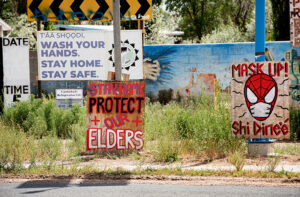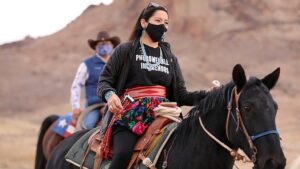Navajo Nation
Practicing ‘Full Presence’
November 20, 2020Navajo Nation
Learn how cultivating trust and community allowed Health Initiative to be effective partners in the region.
Dr. Sriram Shamasunder and his organization, HEAL Initiative, stood in solidarity with Navajo healthcare workers as they fought a COVID outbreak through the spring and summer.
This past summer, when the Navajo Nation was the site of one of the country’s worst coronavirus outbreaks, Dr. Sriram Shamasunder was at Chinle Comprehensive Health Care Facility in Arizona, caring for a Navajo elder in the respiratory care unit. When he was young, the patient had worked in the uranium mines on Navajo land, and he had spent decades drinking water contaminated with the radioactive element. He had poor baseline lung function, and now he had COVID-19. His family could not be there to comfort him. He was isolated and scared.
On harried rounds in the overwhelmed medical center, it was very difficult to be fully present. “I was moving fast. I was wearing goggles, a face shield, an N95 mask,” Shamasunder recalls. He couldn’t speak to the miner in his own language, and he wasn’t intimately familiar with the contours of the man’s life on the reservation. There was a gulf between them that Shamasunder, as his doctor, struggled to cross.
But Shamasunder had not come into the room alone. He was accompanied by Navajo nurses from the local community. “They would just lean over in his ear and speak to him in his own language,” Shamasunder says, “‘I won’t let you go.’ ‘I am from your community, and I’m here to stand with you.’ To bridge that gap is just so powerful.”
Signs encourage safety in the Navajo Nation. Photo credit: UCSF
I think there was a question all of us sat with. What does it mean to lead a purposeful, committed life? What does that look like?
What made HEAL so effective? It may have had something to do with the way HEAL responds to the problem Shamasunder has spent his entire career thinking about: How can the best care be delivered across the human boundaries of language, culture, gender, and religion that arise in our global community? After the technical training of medical school, can young health professionals be trained in the ineffable part of the practice, in leadership, advocacy, and justice?
How can they learn to show up in their full presence?
In May, a disheartening thread of stories about COVID-19 in the Navajo Nation was circulating. Per-capita infection rates soared. Congress had approved $8 billion in coronavirus relief for tribes around the country, but the money did not arrive as committed. It was a cruel echo of the disinvestment that had left the Navajo Nation — an area larger than West Virginia — with just 13 grocery stores and only some 20 ICU beds.
In the wake of this progress, UCSF is compiling a report on the efforts of HEAL and the volunteers in Navajo Nation. Shamasunder’s own reflections, unsurprisingly, have so far taken the form of notes and sketches of new poems that address the work of the health professionals in their full presence, affirming their spirit of partnership and solidarity. He wants to make sure the opportunity to explore those elements of the summer’s efforts is not overlooked — by the medical community, or by HEAL.
And the world must change.
This fall has seen COVID-19 case counts rise around the globe, and the Navajo Nation has not been exempt. In late October, with a surge in New Mexico taking hospitals in Albuquerque beyond their bed capacity, the reservation’s command-control structure re-engaged in planning for case management and potential patient transfers to hospitals all over Arizona and New Mexico. Just this week, after announcing that 34 Navajo communities have “uncontrolled spread” of the disease, the nation’s leadership instituted a three-week lockdown restricting nonessential activities. Shamasunder is trying to coordinate another team of nurses to travel down to Arizona and New Mexico to help. If he is needed, there is no question that he would return to the desert.
Full piece:
Navajo Nation
November 14, 2020NPR/Kalyani Saxena
‘Hoping to increase young Native American voter turn-out, Allie Young, 30 year-old member of the Navajo Nation, started “Ride to the Polls”—she led groups of voters, ranging from 18-30, 10-miles on horseback to reach polling stations in Kayenta, AZ.’
How The Navajo Nation Helped Flip Arizona For Democrats
According to Vox, 60% to 90% of the Navajo Nation’s roughly 67,000 eligible voters voted for Biden. [AZ was called for Biden this week.]
Members of the Navajo Nation often face high barriers to voting. Many people are not assigned a physical address and are unable to register to vote. Tara Benally, field director for the Rural Utah Project, described to NPR’s Mary Louise Kelly about how the organization managed to register 4,000 Native American voters in Arizona.
The project worked with Google to provide GPS coordinates in lieu of physical addresses. Organizers also left thousands of Ziploc bags with voter registration forms on the doors of Native American voters to avoid the spread of COVID-19.
Reflecting on the Navajo people’s unprecedented turnout, he said: “I appreciate meeting with Joe Biden and Kamala Harris in Phoenix. … [We had] a dialogue, and I think those types of events really inspired the Native American voters to come out to the polls and cast their votes for change.”
#NativeAmericanHeritageMonth
Rep. Deb Haaland (D-N.M.) said that she would happily take on the role of President-elect Joe Biden’s secretary of the Interior if the job were offered to her, according to HuffPost. “Oh yes, of course.” @RepDebHaaland



